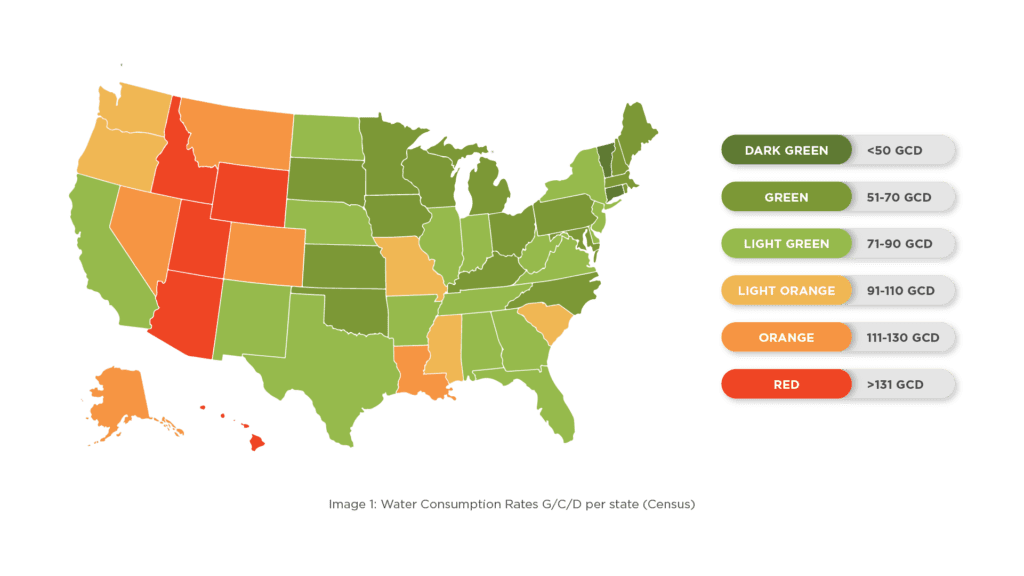Water. The liquid of life. Those of us living in the United States and other first-world countries have come to take this resource for granted. We have perpetual access to what feels like an unlimited supply of fresh drinkable water. However, we must remember that this is one of the planet’s most valuable resources and it’s more scarce than we might think.
Every person on this planet relies on multiple gallons of water each day for basic functions such as drinking, cooking, and hygiene. On top of this need, many of us use orders of magnitude more for other purposes. Activities such as watering our grass or washing our cars contribute to some of this frivolous usage but much of it is consumed in the production of the foods we eat, the things we buy, and many other non-obvious lifestyle decisions.
For these reasons, the average person’s water consumption has increased steadily over time. Compounding this, the world’s population has more than doubled in the last 50 years. There are now more people than ever who need access to clean water, but at the same time, we know that this is becoming more challenging. Only 0.5% of the earth’s water is accessible fresh liquid water, with the remaining 99.5% split between being unviable for drinking in its natural state in the oceans (97%) or existing in other forms such as ice caps, soil, atmosphere and plantation (2.5%).
To make matters worse, rising global temperatures (+0.65℃ since 1971), shifting rainfall patterns, diminishing bodies of freshwater, and extreme weather events all contribute to widespread water access issues. In short, the supply is small to start with and is getting harder to access. Meanwhile, the demand is ever on the rise.
The world’s well is running dry
The water shortage problem is already currently happening in Mexico City, one of the largest cities in the world. So it is more important than ever for us to not only consider our water usage but also help solve this growing global problem.
We can start by looking at water usage here in the US. According to the U.S. Bureau of Reclamation (USBR) and Geological Survey (USGS), 39 billion gallons of water per day (Bgal/day) are consumed in a domestic environment, 118 Bgal/day for agriculture, and 175 Bgal/day for industrial applications including thermoelectric power in the US. This comes out to a staggering 322 Bgal/day total.
When this information is broken down by capita, we can see how and where this water is being consumed. From data collected in the 2015 Census and the USGS, the reported population at the time of the study in the United States was 325M, with 283M relying on public water companies to supply their needed water. The remaining 42M employ water extraction solutions on their properties or neighboring water resources.
From this information, we can see the average water consumption by state in gallons per capita per day (g/c/d). The quantity of water varies from 35 g/c/d in Connecticut to 176 g/c/d in Wyoming, with an average usage of 82 g/c/d. The infographic below shows the distribution of water usage on a state-by-state basis. It should be noted that these reported values do not break down other factors that come into play concerning water consumption, such as pets, private/non-commercial farms, swimming pools, and other aspects that consume high quantities of water.
From a larger investigation into the figures from the Bureau of Reclamation, it can be seen that the average member of the U.S. population uses 600 g/d through food generation and consumerism (this includes the production of clothing, energy, food, transport, packaging, etc.).

Change our habits, save the world
The United Nations has estimated that the world’s population will reach 10 billion by the early 2050s (the current population as of 1/1/24 is estimated to be 8 billion), resulting in a 25% growth over the next 30 years. Where is this water going to come from? It has been reported that the U.S. is the 2nd largest user of water per capita in the world, just behind the United Arab Emirates — but with a population over 35 times larger, small changes to habits in the U.S. would make a significant impact. If everyone in the U.S. could reduce their water consumption by 20% (16.4 g/day) during this time, the existing infrastructure could support the population. Granted, this does not consider the increased demand on industrial applications and energy generation, but it is a step in the right direction for a greener future.
Innovation within the field of water management and optimization is expected to grow by leaps and bounds over the upcoming years as we address the effects of climate change and population growth, but it is going to take everyone’s help to change the future.
The global population has a decision to make. Are we going to continue to consume water at this ever-increasing rate and divert more water from freshwater locations, such as rivers, lakes, and groundwater? Or are we going to optimize and improve our efficiencies?
This is the first article in our new water management and optimization series. We’ll explore several approaches to water optimization in future articles focused on personal awareness, optimizing home water systems, infrastructure improvements, and alternative sources of water and purification.

